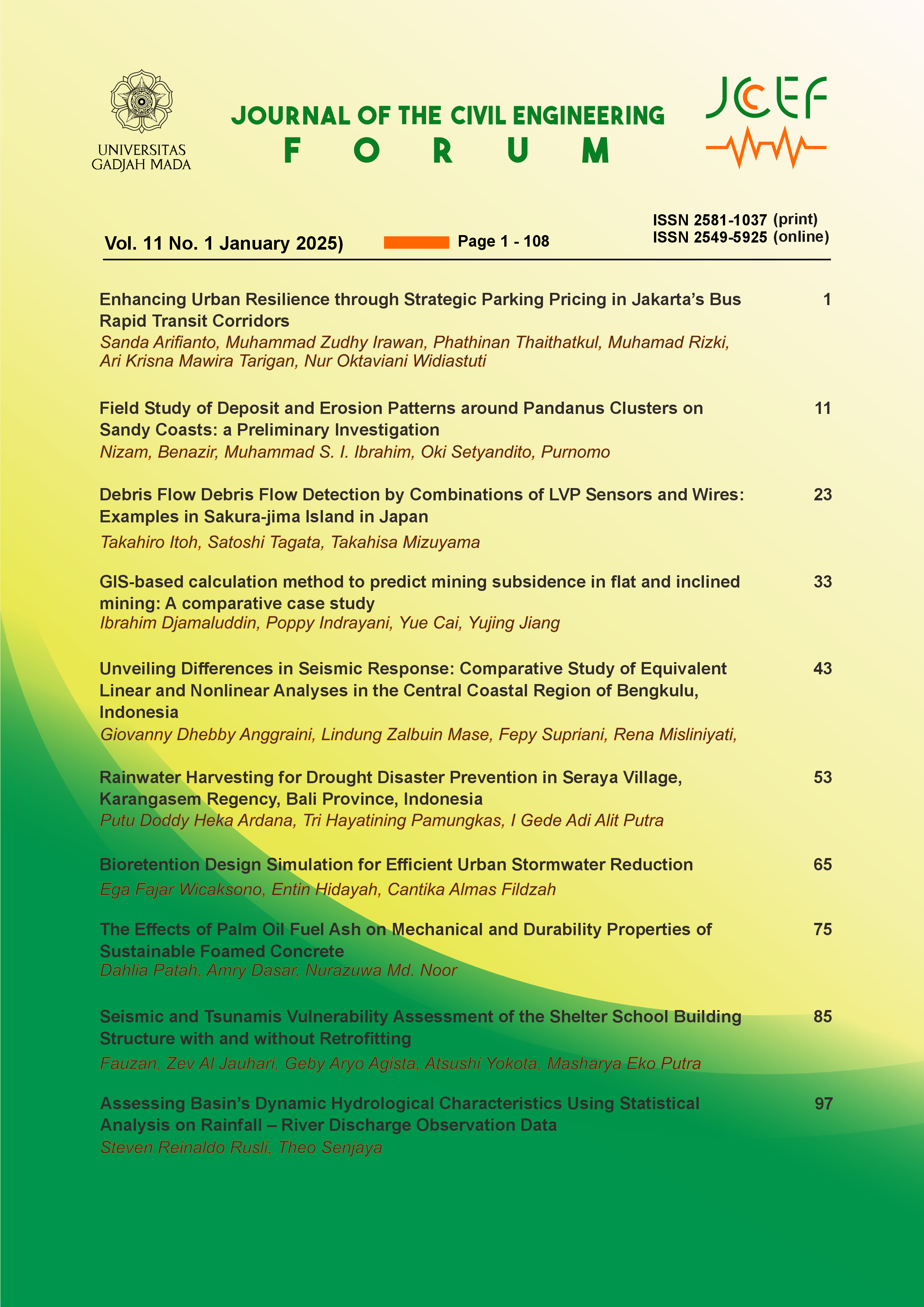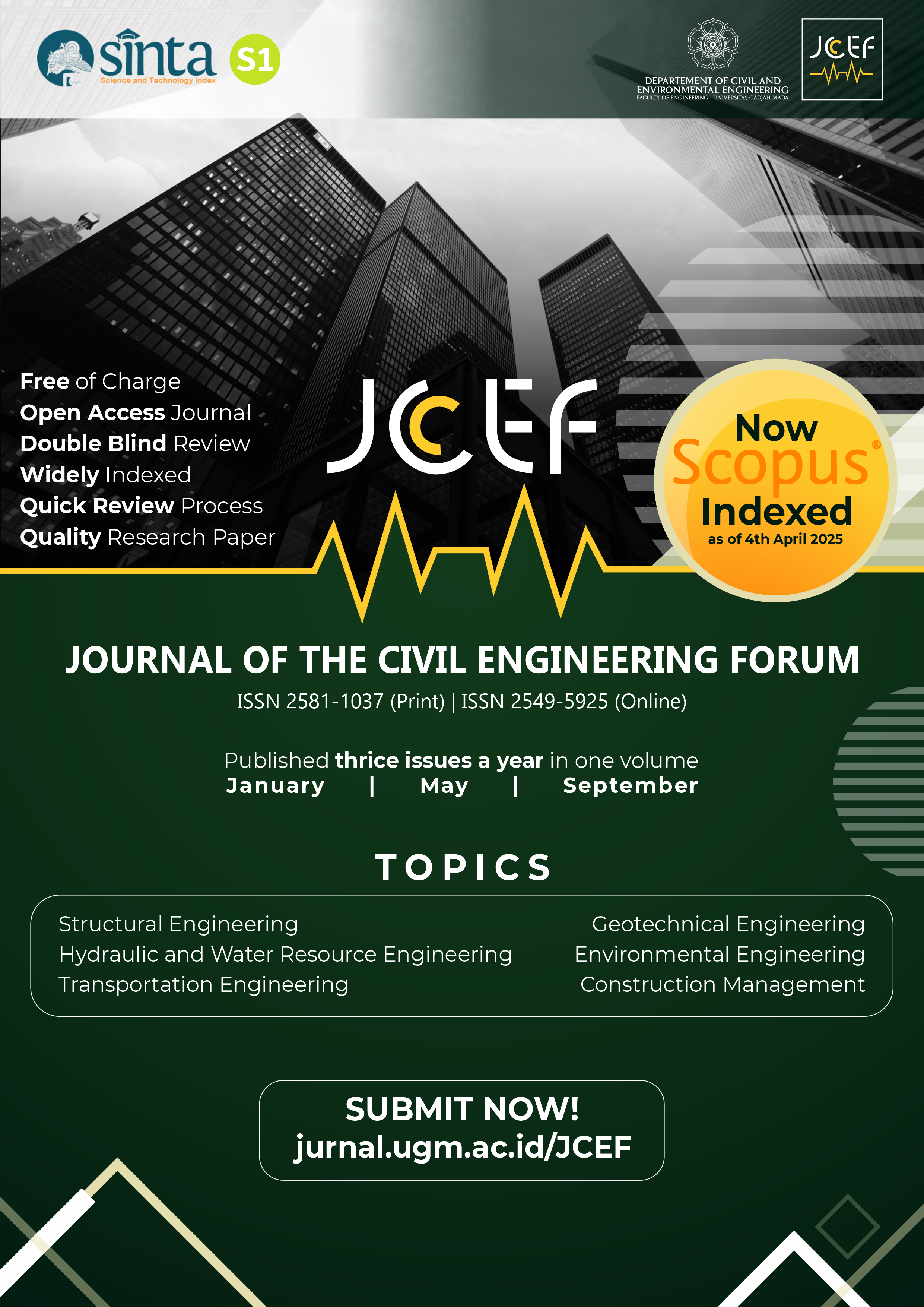Bioretention Design Simulation for Efficient Urban Stormwater Reduction
Abstract
The population increases, leading to extensive urbanization and the consequent rise in impervious surfaces. This urbanization trend has exacerbated stormwater runoff issues, necessitating sustainable stormwater management strategies. Low Impact Development (LID) techniques, such as bioretention, have emerged as promising solutions to mitigate the adverse effects of increased impervious surfaces on stormwater management. Through drainage simulation using EPA SWMM 5.2 software, this study assessed the effectiveness of bioretention in mitigating stormwater runoff within Pesona Regency Housing in Jember Regency. In this approach, hydrological techniques use rainfall for a 2-year return period based on the typology of the study area. The bioretention scenarios used coverage of 5%, 10%, and 20% of the subcatchment area as Scenario 1, 2, and 3. The simulation revealed promising reductions in peak runoff discharge across various scenarios, with average reduction rates of 80%, 88%, and 92% for Scenarios 1, 2, and 3, respectively. However, the effectiveness of bioretention varied across different junctions and scenarios due to factors such as location, junction area coverage, soil properties, and local drainage patterns. While larger bioretention areas generally resulted in greater runoff reduction, the study underscores the importance of considering location and cost-effectiveness in bioretention design. Overall, this research provides valuable insights into the efficacy of bioretention as a stormwater management strategy in rapidly urbanizing areas, offering guidance for property developers in planning flood-resistant housing with LID bioretention.
References
Al-Timimi, Y. K., Al-Lami, A. M., & Al-Shamarti, H. K. (2020). Calculation of the mean annual rainfall in iraq using several methods in gis. Plant Archives, 20, 1156–1160.
Amin, M. B. AL. (2020). Pemodelan Sistem Drainase Perkotaan Menggunakan SWMM. PENERBIT DEEPUBLISH.
Amrulloh, M., Widiarti, W. Y., & Halik, G. (2021). Evaluasi Kinerja Sistem Drainase Jalan Kaliurang Kecamatan Sumbersari Kabupaten Jember Evaluation Performance of the Kaliurang Road Drainage System at. 12(2), 81–91.
Andajani, S., & Hidayat, D. P. . (2019). Evaluasi Faktor Teknis Penentu Kriteria Drainase Berwawasan Lingkungan. Indonesian Journal of Construction Engineering and Sustainable Development (Cesd), 2(1), 1–5. https://doi.org/10.25105/cesd.v2i1.6012
Bond, J., Batchabani, E., Fuamba, M., Courchesne, D., & Trudel, G. (2021). Modeling a Bioretention Basin and Vegetated Swale with a Trapezoidal Cross Section using SWMM LID Controls. Journal of Water Management Modeling, 29, 1–15. https://doi.org/10.14796/JWMM.C474
BPS. (2021). Hasil Sensus Penduduk 2020 Kabupaten Jember. Badan Pusat Statistik Kabupaten Jember, 1–5. https://jemberkab.bps.go.id/pressrelease/2021/01/25/199/hasil-sensus-penduduk-2020-kabupaten-jember.html#:~:text=Dengan luas wilayah 3.293,34,770 jiwa per km2.
Butcher, J. B. (2021). Storm Intensification: Implications for Environmental Design in Maryland. Journal of Water Resources Planning and Management, 147(10). https://doi.org/10.1061/(asce)wr.1943-5452.0001448
Danasla, M. A., Kusuma, G. J., Tuheteru, E. J., & Gautama, R. S. (2021). Hydrology model establishment of pit lake: Extreme event rainfall data analysis. IOP Conference Series: Earth and Environmental Science, 882(1). https://doi.org/10.1088/1755-1315/882/1/012048
de Macedo, M. B., do Lago, C. A. F., & Mendiondo, E. M. (2019). Stormwater volume reduction and water quality improvement by bioretention: Potentials and challenges for water security in a subtropical catchment. Science of the Total Environment, 647, 923–931. https://doi.org/10.1016/j.scitotenv.2018.08.002
Goor, J., Cantelon, J., Smart, C. C., & Robinson, C. E. (2021). Seasonal performance of field bioretention systems in retaining phosphorus in a cold climate: Influence of prolonged road salt application. Science of The Total Environment, 778, 146069. https://doi.org/10.1016/j.scitotenv.2021.146069
Greksa, A., Grabić, J., & Blagojević, B. (2022). Contribution of low impact development practices-bioretention systems towards urban flood resilience: case study of Novi Sad, Serbia. Environmental Engineering Research, 27(4), 0–3. https://doi.org/10.4491/eer.2021.125
Guzha, A. C., Rufino, M. C., Okoth, S., Jacobs, S., & Nóbrega, R. L. B. (2018). Impacts of land use and land cover change on surface runoff, discharge and low flows: Evidence from East Africa. Journal of Hydrology: Regional Studies, 15, 49–67. https://doi.org/10.1016/j.ejrh.2017.11.005
Hidayah, E., Widiarti, W. ., Wiyono, R. U. ., Dermawan, V., Fadhilah, D., & Tahir, C. (2024). Benefit–cost analysis of a low-impact development design. Water Practice and Technology, 0(0), 1–10. https://doi.org/10.2166/wst.2011.079
Jiang, C., Li, J., Li, H., Li, Y., & Chen, L. (2017). Field Performance of Bioretention Systems for Runoff Quantity Regulation and Pollutant Removal. Water, Air, & Soil Pollution, 228(12), 468. https://doi.org/10.1007/s11270-017-3636-6
Lee, J. M., Park, M., Min, J. H., Kim, J., Lee, J., Jang, H., & Na, E. H. (2022). Evaluation of SWMM-LID Modeling Applicability Considering Regional Characteristics for Optimal Management of Non-Point Pollutant Sources. Sustainability (Switzerland), 14(21). https://doi.org/10.3390/su142114662
Limantara, L. M. (2018). Rekayasa Hidrologi (R. I. Utami (ed.)). Penerbit ANDI.
Liu, A., Egodawatta, P., & Goonetilleke, A. (2022). Ranking Three Water Sensitive Urban Design (WSUD) Practices Based on Hydraulic and Water Quality Treatment Performance: Implications for Effective Stormwater Treatment Design. Water (Switzerland), 14(8). https://doi.org/10.3390/w14081296
Liu, W., Feng, Q., Deo, R. C., Yao, L., & Wei, W. (2020). Experimental Study on the Rainfall-Runoff Responses of Typical Urban Surfaces and Two Green Infrastructures Using Scale-Based Models. Environmental Management, 66(4). https://doi.org/10.1007/s00267-020-01339-9
Mahmoud, A., Alam, T., Yeasir A. Rahman, M., Sanchez, A., Guerrero, J., & Jones, K. D. (2019). Evaluation of field-scale stormwater bioretention structure flow and pollutant load reductions in a semi-arid coastal climate. Ecological Engineering, 142, 100007. https://doi.org/10.1016/j.ecoena.2019.100007
Manto, A., & Kadri, T. (2020). Reduksi Debit Limpasan Dengan Menerapkan Sistem Ekodrainase Pada Kawasan Perumahan. Indonesian Journal of Construction Engineering and Sustainable Development (Cesd), 3(2), 104–109. https://doi.org/10.25105/cesd.v3i2.8552
Nazarpour, S., Gnecco, I., & Palla, A. (2023). Evaluating the Effectiveness of Bioretention Cells for Urban Stormwater Management: A Systematic Review. Water (Switzerland), 15(5). https://doi.org/10.3390/w15050913
Nowogoński, I. (2021). Runoff volume reduction using green infrastructure. Land, 10(3). https://doi.org/10.3390/land10030297
Öhrn Sagrelius, P., Blecken, G., Hedström, A., Ashley, R., & Viklander, M. (2022). Environmental impacts of stormwater bioretention systems with various design and construction components. Journal of Cleaner Production, 359. https://doi.org/10.1016/j.jclepro.2022.132091
Peraturan Menteri Pekerjaan Umum Republik Indonesia Nomor 12/PRT/M/2014 Tentang Penyelenggaraan Sistem Drainase Perkotaan, Pub. L. No. 12/PRT/M/2014 (2014).
Priambodo, S., Suhardjono, Montarcih, L., & Suhartanto, E. (2019). Hourly rainfall distribution patterns in Java island. MATEC Web of Conferences, 276, 04012. https://doi.org/10.1051/matecconf/201927604012
Putri, F. K., Hidayah, E., & Ma’ruf, M. F. (2023). Enhancing stormwater management with low impact development (LID): a review of the rain barrel, bioretention, and permeable pavement applicability in Indonesia. Water Science and Technology, 87(9). https://doi.org/10.2166/wst.2023.095
Qin, Y. (2020). Urban Flooding Mitigation Techniques: A Systematic Review and Future Srudies.
Rossman, L. A. (2016). Storm Water Management Model Reference Manual (Volume III). United States Enviromental Protection Agency.
Spraakman, S., Rodgers, T. F. M., Monri-Fung, H., Nowicki, A., Diamond, M. L., Passeport, E., Thuna, M., & Drake, J. (2020). A need for standardized reporting: A scoping review of bioretention research 2000–2019. Water (Switzerland), 12(11), 1–35. https://doi.org/10.3390/w12113122
Spraakman, S., Van Seters, T., Drake, J., & Passeport, E. (2020). How has it changed? A comparative field evaluation of bioretention infiltration and treatment performance post-construction and at maturity. Ecological Engineering, 158, 106036. https://doi.org/10.1016/j.ecoleng.2020.106036
Stec, A., & Słyś, D. (2023). New Bioretention Drainage Channel as One of the Low-Impact Development Solutions: A Case Study from Poland. Resources, 12(7). https://doi.org/10.3390/resources12070082
Tamimi, R., Wahyuni, S., & Hidayah, E. (2016). Kajian Evaluasi Sistem Drainase Jalan Srikoyo Kecamatan Patrang Kabupaten Jember (Evaluation of Drainage System in Jalan Srikoyo Kecamatan Patrang Kabupaten Jember). Jurnal Rekayasa Sipil Dan Lingkungan, 1(01), 18. https://doi.org/10.19184/jrsl.v1i01.3741
Tansar, H., Duan, H. F., & Mark, O. (2022). Catchment-Scale and Local-Scale Based Evaluation of LID Effectiveness on Urban Drainage System Performance. Water Resources Management, 36(2), 507–526. https://doi.org/10.1007/s11269-021-03036-6
Vijayaraghavan, K., Biswal, B. K., Adam, M. G., Soh, S. H., Tsen-Tieng, D. L., Davis, A. P., Chew, S. H., Tan, P. Y., Babovic, V., & Balasubramanian, R. (2021). Bioretention systems for stormwater management: Recent advances and future prospects. Journal of Environmental Management, 292(January), 112766. https://doi.org/10.1016/j.jenvman.2021.112766
Wałȩga, A., Cebulska, M., & Gadek, W. (2018). The use of bioretention cell to decreasing outflow from parking lot. Journal of Water and Land Development, 36(1), 173–181. https://doi.org/10.2478/jwld-2018-0017
Wang, M., Zhang, D., Wang, Z., Zhou, S., & Tan, S. K. (2021). Long-term performance of bioretention systems in storm runoff management under climate change and life-cycle condition. Sustainable Cities and Society, 65(March), 102598. https://doi.org/10.1016/j.scs.2020.102598
Willard, L. L., Wynn-Thompson, T., Krometis, L. H., Neher, T. P., & Badgley, B. D. (2017). Does It Pay to be Mature? Evaluation of Bioretention Cell Performance Seven Years Postconstruction. Journal of Environmental Engineering, 143(9). https://doi.org/10.1061/(ASCE)EE.1943-7870.0001232
Zeng, J., Huang, G., Mai, Y., & Chen, W. (2020). Optimizing the cost-effectiveness of low impact development (LID) practices using an analytical probabilistic approach. Urban Water Journal, 17(2), 136–143. https://doi.org/10.1080/1573062X.2020.1748208
Zhang, L., Lu, Q., Ding, Y., & Wu, J. (2021). A procedure to design road bioretention soil media based on runoff reduction and pollutant removal performance. Journal of Cleaner Production, 287. https://doi.org/10.1016/j.jclepro.2020.125524
Copyright (c) 2025 The Author(s)

This work is licensed under a Creative Commons Attribution-ShareAlike 4.0 International License.
Copyright is granted to authors for the purpose of providing protection for articles written to describe experiments and their results. JCEF will protect and defend the work and reputation of the author and are also willing to address any allegations of violation, plagiarism, fraud, etc. against articles written and published by JCEF. JCEF is published under the terms of the Creative Commons Attribution-ShareAlike 4.0 International License (CC BY-SA 4.0). The author holds the copyright and assigns the journal rights to the first publication (online and print) of the work simultaneously.







